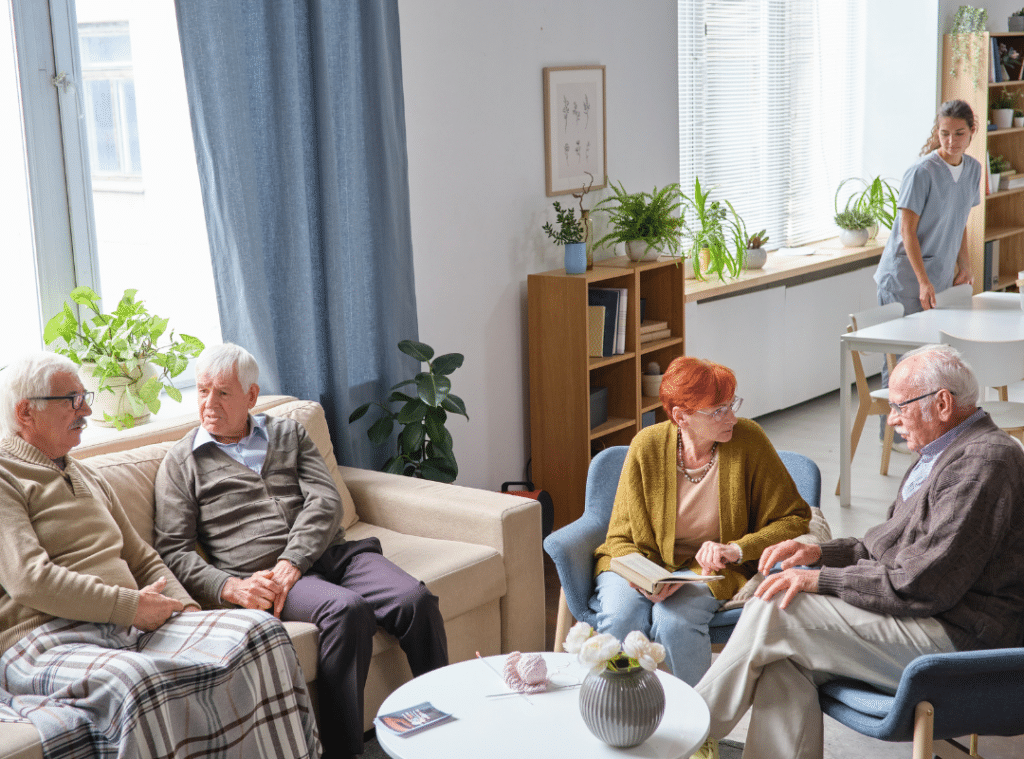Elderly Group Homes: Finding Comfort Near Pinole, CA
Elderly group homes are designed to offer a warm, home-like environment with professional care tailored for older adults. For families searching for safe and comfortable options near Pinole, CA, communities like Westmont of Pinole stand out for their personalized approach to care. These intimate settings are not just about assistance; they create meaningful experiences through daily routines, community interaction, and compassionate support. Understanding what these homes offer is key as a resident or a loved one exploring senior living. From affordability to healthcare access, elderly group homes provide a viable alternative to larger facilities. They promote independence while ensuring safety, offering the best of both worlds. And with increasing demand, it’s more important than ever to understand how to choose the right one.
Schedule a Tour at Westmont of Pinole and discover a new care experience.
What Makes Elderly Group Homes Unique?
Unlike traditional assisted living, elderly group homes offer a more personal and relaxed setting. Most homes accommodate only six to ten residents, which allows for closer bonds between staff and residents. These smaller environments are ideal for fostering emotional well-being and meeting each resident’s needs. Especially in areas like Pinole, options such as group homes for seniors near Pinole, CA are gaining attention due to their balance of affordability and quality. The focus is on dignity, respect, and maintaining independence for as long as possible. Because of their scale, these homes also offer quicker response times and greater customization in care.
Understanding Senior Group Home Cost
Affordability is often one of the biggest concerns when considering elderly group homes. Fortunately, many homes present cost-effective options when compared to larger communities. The senior group home cost typically includes meals, housekeeping, assistance with daily tasks, and sometimes medical support. In Pinole, CA, this makes tiny group homes an attractive option for those on a budget. It’s essential to clarify what each home includes in its pricing to avoid unexpected fees. Medicaid and long-term care insurance may help cover costs, making it more accessible to families. Learn more about navigating assisted living costs and what your monthly expenses might look like.
Private Homes for Elderly Care: A Personal Approach
When researching private homes for elderly care, families often discover the advantage of personalized routines and smaller staff-to-resident ratios. These homes offer a level of customization not commonly found in more extensive facilities. From preferred wake-up times to favorite meals, the daily schedule adapts to individual lifestyles. Residents benefit from familiar surroundings and consistent caregivers, which can make transitions smoother, especially for those with memory conditions. Private homes emphasize comfort, familiarity, and continuity of care, enhancing aging individuals’ overall quality of life.
Group Homes for Low-Income Seniors
For families with limited financial resources, group homes for low-income seniors provide an essential service. Some communities, including those in Contra Costa County, offer sliding scale pricing or accept Medicaid waivers. This ensures that quality care remains accessible regardless of income level. The key is researching which local homes participate in assistance programs and offer transparent cost structures. At Westmont of Pinole, our team works closely with families to help them understand financial options and eligibility.
You can explore how affordable group homes support seniors without compromising care.
Healthcare Access in Elderly Group Homes
Access to healthcare is a cornerstone of any quality group home. Most elderly group homes coordinate with local clinics, pharmacies, and medical specialists to provide timely care. This may include scheduled physician visits, telehealth services, or in-house support for chronic conditions. The goal is to ensure residents remain healthy without needing to travel frequently. Westmont of Pinole prioritizes healthcare coordination, offering solutions that minimize disruption to residents’ routines. Transportation for medical appointments is also typically available, contributing to peace of mind for families.
Daily Living in Private Group Homes for Seniors
A defining feature of private group homes for seniors is the attention to daily life. Every aspect of the house—from dining to activities—is designed to feel comforting and familiar. Residents enjoy shared meals, light exercise classes, creative arts sessions, and casual social interaction. This engagement is vital to emotional health, especially for seniors who may otherwise feel isolated. Homes like Westmont of Pinole help residents maintain a strong sense of identity and purpose by fostering a welcoming, community-focused environment.
Read more about the value of social interaction in senior living settings.

Evaluating the Right Fit for Your Loved One
Finding the right group home requires more than a quick internet search. It’s crucial to schedule visits, meet the staff, and observe how current residents interact. Pay attention to the atmosphere: Is it calm, clean, and welcoming? Does the staff know residents by name? Homes like Westmont of Pinole stand out because they offer tailored support with a family-like approach. Don’t hesitate to ask about licensing, care plans, and the types of residents they typically serve. Making the right choice involves blending practical needs with emotional comfort.
Your Next Step
Whether you’re searching for Group homes for seniors near Pinole, CA, or evaluating private group homes for seniors for a loved one, knowing your options is crucial. The ideal home should meet medical needs, support daily life, and offer a community atmosphere that feels just right. With its dedication to compassionate care, Westmont of Pinole remains a trusted option for many families.
Take the next step and Schedule a Tour today to see how your loved one could thrive in a supportive, loving environment.
How Do The Costs Of Moving Into A Quality Senior Care Community Compare With The Costs Of Staying At Home?Compare The Costs of Senior Living vs Staying at Home
Frequently Asked Questions
What are group homes for the elderly?
Group homes for the elderly are residential care facilities that provide a supportive living environment for seniors who need help with daily activities but do not require full-time medical care. These homes usually accommodate a small number of residents, allowing for more personalized attention. Services often include meals, housekeeping, medication management, and assistance with bathing or dressing. Group homes offer a homelike setting that encourages social interaction and community living.
What are the disadvantages of a group home?
While group homes offer a close-knit and supportive environment, they may not be ideal for everyone. One drawback is the limited number of residents, which can restrict social variety or activities. Additionally, medical care is usually unavailable on-site around the clock, so seniors with complex health needs may require additional support. Personal preferences for more independence or privacy might also be more complicated to accommodate in a group setting.
What is the average cost of a group home?
The cost of a group home varies by location, level of care, and amenities offered, but it ranges from $2,500 to $6,000 per month. In areas with a higher cost of living, prices can exceed this range. This cost typically includes housing, meals, and personal care services. Unlike nursing homes, group homes may offer more affordable care for seniors who don’t need intensive medical assistance.
Does Medicare cover group homes?
Medicare generally does not cover the cost of room and board in group homes for the elderly. However, if deemed medically necessary, it may cover certain medical services provided to residents, such as doctor visits or skilled nursing care. Most group home costs are paid out-of-pocket or through other programs like Medicaid, long-term care insurance, or veterans’ benefits. Reviewing available options to understand what financial assistance may apply is essential.








